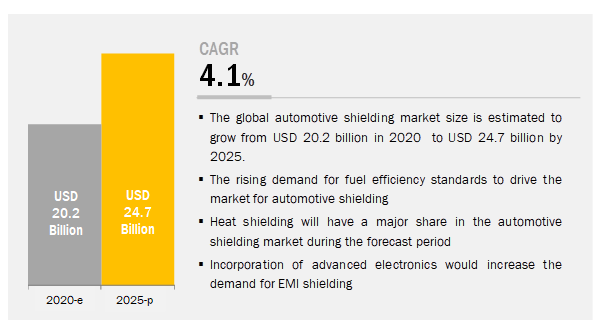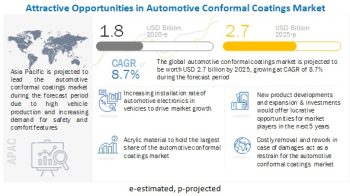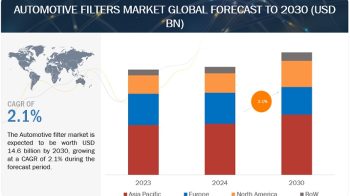
The report “Automotive Shielding Market by Shielding (Heat, EMI), Heat Application (Engine, Turbocharger, Battery Management, Fuel Tank), EMI Application (ACC, ECU, LDW, BSD, AEB, FCW, DMS), Material Type, Vehicle (PC, LCV, HCV), and Region – Global Forecast to 2025″, is projected to grow from USD 20.2 billion in 2020 to USD 24.7 billion by 2025, at a CAGR of 4.1%. The market is driven by factors such as the rising demand for fuel-efficient vehicles, growing safety concerns, and the high adoption rate of advanced electrical and electronic components in vehicles. In addition, increasing focus on driving comfort and in-cabin experience would fuel the demand for heat and EMI shielding during the forecast period.
Engine control module, which is also known as Electronic Control Unit (ECU), is a term used for any embedded system that controls one or more electrical systems/subsystems in a vehicle. Modern-day vehicles can have more than 50 ECUs. The ECU gathers data from sensors installed in a vehicle. It uses this data to enhance the working of various operations such as the timing of fuel injection, spark timing, stability control, and in-vehicle telematics.
Download PDF Brochure @ https://www.marketsandmarkets.com/pdfdownloadNew.asp?id=221737808
The EMI shielding market for ECM is expected to increase due to the increased use of ECMs in a vehicle. The number of ECMs in a vehicle has increased due to factors such as rising demand for advanced electrical & electronic components, emission regulations, and safety & security concerns. In addition, the growing demand for high performance engines in the luxury vehicle segment is expected to increase the need for EMI shielding for ECM. ECM is responsible for air-fuel mixture, ignition timing, and valve timing. High performance engines require advanced ECM to deliver the desired performance.
Exhaust system segment is expected to lead among heat applications in the automotive shielding market
The exhaust system heat shield retains heat in the exhaust system of the vehicle and acts as a thermal barrier for exhaust components. Exhaust system heat shields are used in the muffler, exhaust manifolds, catalytic convertor, and exhaust downpipe. These heat shields can reduce 70% of the heat radiating from the exhaust system.
Most of the vehicles are now equipped with exhaust system heat shields to reduce the amount of heat radiated by the exhaust system and protect the other body parts. Increasing stringency of fuel economy standards in the EU, Japan, and China has led OEMs to focus on vehicle lightweighting and aerodynamics. In December 2018, the European Commission presented a bill to set fuel economy standards. It aimed to reduce the average CO2 emission of passenger cars and vans by 15% in 2025 and 37.5% in 2030. For light commercial vehicles, the authority targeted to cut down emissions by 15% in 2025 and 31% in 2030.
Request Free Sample Report @ https://www.marketsandmarkets.com/requestsampleNew.asp?id=221737808
Asia Pacific is expected to be the largest market by 2025
China, India, and Japan account for the largest shares of the automotive shielding market in Asia Pacific. The growth of the market in Asia Pacific can be attributed to the high vehicle production and increased use of advanced electronics in Japan, South Korea, India, and China. The governments of these countries have recognized the growth potential of the automotive industry and have consequently taken different initiatives to encourage major OEMs to enter their domestic markets. This has led to an increase in vehicle production volumes over the years, which caters not only to domestic demand but also overseas demand.
Key Players:
The automotive shielding market is dominated by global players such as Tenneco Inc (US), Laird (UK), Henkel (Germany), Dana Incorporated (US), Morgan Advanced Materials (UK), 3M (US), Parker Hannifin (Chomerics) (US), and KGS KITAGAWA INDUSTRIES CO (Japan). These companies have adopted strategies of new product development, expansion, collaborations, partnerships, and mergers & acquisitions to gain traction in the automotive shielding market.
Critical Questions:
- Where will the introduction of stringent emission regulations and fuel efficiency standards take the industry in the long term?
- How are increasing light weighting measures going to shape the automotive shielding market?
- What will be the impact on the market with respect to the increasing adoption of advanced electronics?
- What is the impact of developments in autonomous driving on the automotive shielding market?
- What are the upcoming trends in the automotive shielding market? What impact would they make post-2022?
- What are the key strategies adopted by top market players to increase their revenue?
To speak to our analyst for a discussion on the above findings, click Speak to Analyst


